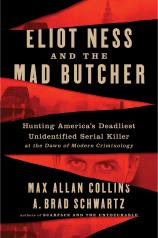Eliot Ness and the Mad Butcher: Hunting a Serial Killer at the Dawn of Modern Criminology
Review
Eliot Ness and the Mad Butcher: Hunting a Serial Killer at the Dawn of Modern Criminology
In 1934, Cleveland, Ohio, welcomed the most famous G-Man at the time: Eliot Ness. He was fresh off his huge successes in Chicago, Illinois, where he and his self-proclaimed team, the Untouchables, had cleaned up the Windy City by putting away the infamous gangster Al Capone and several of his cronies. Now, Ness was expected to do the same on a lesser scale in Cleveland.
However, unexpectedly, Ness' move would be synonymous with a murder wave, unlike anything the city had ever seen previously. This was still years before the official term “serial killer” was used, but that's exactly what this was --- a series of grotesque, grisly murders involving dismemberment and beheadings. These horrific crimes were supposedly the work of one individual, dubbed the Mad Butcher. Ness, who thought he had come to Cleveland to battle police corruption and the mob, was now about to face off with the man who eventually would become America's deadliest unidentified serial killer.
"...a meticulously researched work of nonfiction that revolves around these murders.... The irony of Ness' arrival in Cleveland coinciding with the discovery of body parts littering Lake Erie would symbolize one of the only black marks on his otherwise legendary career."
I was not familiar with this case until 1994 when I picked up John Peyton Cooke’s TORSOS, a fictionalized recounting of the Torso Killer, aka the Mad Butcher. This fascinating novel made me realize how underplayed these events have been in popular culture, especially in deference to the dozens of other serial killers who have been immortalized in this country. Enter Max Allan Collins and A. Brad Schwartz, whose latest collaboration, ELIOT NESS AND THE MAD BUTCHER, is a meticulously researched work of nonfiction that revolves around these murders.
The fact that only two people were ever properly identified among all of the body parts collected shows how difficult it would have been to tie anyone to these crimes. It was believed that the killer must have come from the Eastern European population that represented a good part of Cleveland's lower and lower-middle-class neighborhoods. The first suspect was Francis Edward Sweeney, also known as Doctor X. Although nothing was ever proven, Ness was positive that Sweeney was the culprit. In fact, he antagonized Sweeney so much that he began receiving odd and threatening postcards shortly after questioning him. They would continue arriving sporadically until just prior to Sweeney's death in 1964.
Frank Dolezal, a 52-year-old Bohemian immigrant working as a bricklayer, suddenly became the most prominent suspect. He was taken in after confessing to killing Flo Polillo, one of the two identified victims, which he claimed was self-defense. Ness was not confident in Dolezal being their man, but it looked good in the papers and the police finally had a chance to claim victory. However, it wasn’t long before Dolezal was found hanging from a rag-fashioned noose. The coroner's report revealed that it was more likely that he was strangled rather than dying at his own hand. In any event, the possibility of ever proving that he was the Mad Butcher was now out the window.
The irony of Ness' arrival in Cleveland coinciding with the discovery of body parts littering Lake Erie would symbolize one of the only black marks on his otherwise legendary career. That he was never able to arrest and try someone for these crimes is a reflection of Ness being pulled in too many directions to truly focus on the task at hand and the sad reality that the killer was nearly impossible to pin down.
Reviewed by Ray Palen on August 14, 2020
Eliot Ness and the Mad Butcher: Hunting a Serial Killer at the Dawn of Modern Criminology
- Publication Date: July 13, 2021
- Genres: Nonfiction, True Crime
- Paperback: 576 pages
- Publisher: William Morrow Paperbacks
- ISBN-10: 0062881981
- ISBN-13: 9780062881984





